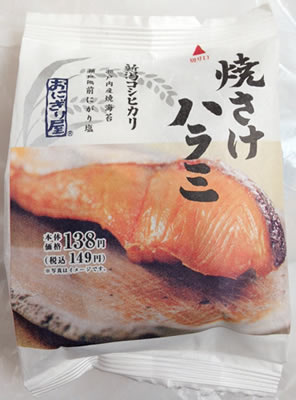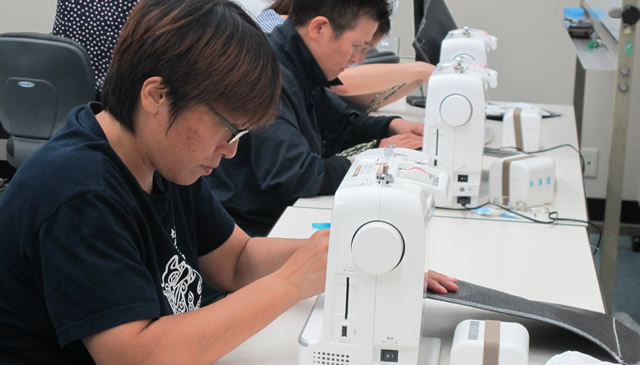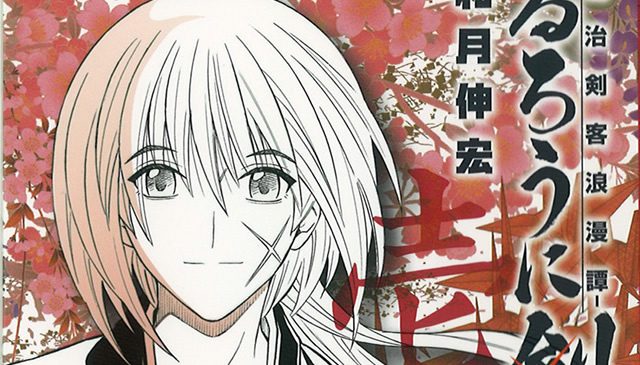-
[From September Issue 2014]
Founded in 1975, Lawson was the first chain of convenience stores to open branches in every prefecture in Japan. Currently, it has over 10,000 stores nationwide and another 500 stores overseas. Especially popular is the “Uchi Café SWEETS Premium Roll Cake” series, which Lawson started selling in 2009. There are also “Natural Lawson” stores that focus on healthy and environmentally-friendly products.
[No. 1] Pure Roll Cake 152 Yen
This cake features a very fine spongy texture, a subtle sweetness and exceptionally thick and full bodied fresh cream. Only domestic ingredients are used.

[No. 2] Bran Rolls (Two-Piece Set) 116 Yen
Catering to health conscious customers concerned about their sugar intake, these bread rolls are made from wheat bran. Versions are also available with cheese and chocolate fillings.

[No. 3] Rice Ball Shop “Seared Salmon Steak” 138 Yen
As if it were handmade, this rice ball is plump and soft. The taste of the fatty salmon can be enjoyed from the very first bite.

LAWSON[2014年9月号掲載記事]1975年創業。コンビニ業界で初めて日本国内すべての都道府県に出店したコンビニエンスストア。日本全国に1万以上の店舗が、世界に約500店舗がある。2009年から販売する「Uchi Café SWEETSプレミアムロールケーキ」シリーズは特に人気。健康や自然に配慮した「ナチュラルローソン」もある。
【No.1】ピュアロールケーキ 152円
スポンジはきめ細かく、甘さは控えめだがコクと深みのある生クリームが特徴。すべて国産の原材料を使っている。
【No.2】ブランパン2個入 116円
糖質が気になる健康志向のお客の声に応えた、ブラン(ふすま)を使ったパン。チーズやチョコレートが入ったものも。
【No.3】おにぎり屋「焼さけハラミ」138円
手で握ったようなふっくらとした食感。脂ののったうまみたっぷりのサケが一口目から楽しめる。
-
[From September Issue 2014]
Venugopal TENKAYALA
President of Shinko Advisors
“Japanese companies have great technology. In spite of this, when it comes to expanding into India, many people lose their way due to fear of risks and partly due to hesitation. I wanted to lend a helping hand to such companies,” Indian Venugopal TENKAYALA says, explaining why he started his business in Japan.
Tenkayala came to Japan in 2000. “At first, I was thinking of eventually moving on to the United States, but I decided to stay because I liked Japan. I appreciated the safety and cleanliness of things like the water, air, and the excellent infrastructure.” He continued to study, while at the same time gaining business experience in a foreign bank, after which he got permanent residency in Japan.
“I wanted to have a business of my own one day. I gained an MBA in finance in 2010 at McGill University in Canada and that was the impetus for me to begin preparations for starting up a business.” Tenkayala hoped to build on his business experience in Japan. In 2011, he founded Shinko Advisors, a consulting firm, to help Japanese companies expand their businesses into India.
“I recently took about 20 Japanese companies with me on a visit to India, showing them around various cities over the space of four months. In relation to their plans for expansion, I answered their questions on safety, infrastructure, management possibilities and finding local business partners,” he says, explaining part of the work he does. His company now has offices in Chuo Ward, Tokyo Prefecture, as well as in Bangalore in the state of Karnataka, India.
“The strength of Shinko Advisors lies in a good understanding of the business environment in both Japan and India,” says Tenkayala. “Just to give you an example, Japanese companies tend to regard India as a country that has a homogenous culture. In actual fact, India is an immense country in which the culture and laws vary from one region to another. The difference is so great between the north and the south in particular that it’s better to consider them as two countries,” he explains.
Another side to Tenkayala is his teaching career. He’s Vice Chairman and visiting professor at the Shree Institute of Technical Education, a private school in the state of Andhra Pradesh, India. “I’m good at logically breaking down issues that are difficult to understand. When I’m dealing with a client that’s consulting, with students it becomes teaching. For me, consulting and education is practically the same thing. In the future I plan to concentrate my efforts on the business of educating Japanese employees in India.”
“India not only has a large market, but it’s also a country that can be a base from which to sell products to the Middle East and Africa. Although many Japanese companies are sending employees to India these days, there are times when I feel that their international business training is inadequate. I want to train and support such employees, to help Japanese companies launch their business in India more efficiently,” he says.
Shinko Advisors KK
Text: SAZAKI Ryo[2014年9月号掲載記事]株式会社新光アドバイザー代表
ベヌゴパル・テンカヤラさん
「日本の企業はすばらしい技術を持っています。それなのにインドへ進出するとき、リスクを恐れたり、ためらったり、迷ったりしている方が多いんです。そういう会社の手助けをしたいと思いました」とインド出身のベヌゴパル・テンカヤラさんは、日本で起業した理由を語ります。
テンカヤラさんは2000年に来日しました。「最初は、そのうちアメリカへ行こうかなと思っていたんですが、日本が好きになったので住み続けることにしました。水や空気などが安全で清潔なところや、インフラが充実している点が気に入ったんです」。その後外資系銀行でビジネスの経験を積みながら勉強を続け、日本の永住権をとりました。
「いつかは自分のビジネスをやりたいと思っていたんです。2010年、カナダのマギル大学でファイナンスのMBAを取ったことをきっかけに、起業の準備を始めました」。テンカヤラさんは日本でのビジネス経験をいかしたいと思いました。そして2011年、日本企業のインド進出をサポートするコンサルタント会社、株式会社新光アドバイザーを立ち上げました。
「この間は20社ほどの日本企業と一緒にインドを訪れて、4ヵ月間、いろいろな都市を案内しました。治安やインフラはどうか、マネジメントは可能か、現地にパートナーを見つけられるかなどの情報を提供して、プランニングに関わったんです」と仕事の一部を紹介します。会社は、今は東京都中央区とインドのカルナータカ州バンガロールにオフィスを持っています。
「新光アドバイザーの強みは、日本のビジネス事情とインドのビジネス事情の両方をよく知っていることです」とテンカヤラさん。「例えば、日本の企業はインドをひとつの文化圏だと考えがちです。現実には、インドはとても大きい国で地域によって文化や法律が異なります。北と南の違いは特に大きいので、北部と南部は別の国だと考えた方がいいです」と説明します。
テンカヤラさんは教育者の一面も持っています。インドのアンドラ・プラデシュ州にある私立シュリー工科大学の副学長で客員教授です。「私が得意なのは、わからないことを論理的な考え方で解決できることです。そのときの相手が企業ならそれはコンサルティング、学生なら教育になります。だから私にとっては、コンサルティングと教育は同じようなものなんです。今後は日本企業の社員をインドで教育するビジネスにも力を入れるつもりです」。
「インドは市場が大きいだけでなく、中東やアフリカへ物を売る拠点にもなり得る国です。今、多くの日本企業が社員をインドに送り込んでいますが、社員に対する国際ビジネス教育が不充分なのではないかと感じることがあります。私は、そういう社員の方を研修、サポートして、日本企業がより効率的にインド進出できるようお手伝いしたいと思っています」と話します。
株式会社新光アドバイザー
文:砂崎良 -
[From September Issue 2014]
Brother
Sewing machine, typewriter, facsimile, printer and online karaoke system: all of these products make our lives convenient and comfortable. Brother Industries, Ltd., in Nagoya, Aichi Prefecture has produced all of these items. Founded in 1908 as Yasui Sewing Machine Co., the company repaired imported sewing machines.
Before he died, YASUI Kanekichi, the founder of the company, stated in his will to Masayoshi, the eldest son of his ten children, that “you should cooperate with your brothers.” Masayoshi took the opportunity to change the company name to “Yasui Brothers Sewing Machine Co.” and joined forces with his brothers to complete a domestically-made sewing machine. Since then they have used the brand name “Brother.” Brother was later used in their company name, too.
Brother Industries’ defining characteristic is its corporate culture of being up for a challenge and unafraid to fail. For instance, in 1986 the company put the TAKERU, a vending machine for PC software on the market, but in the end the product failed. However, using the technology acquired through developing the machine, an online karaoke system was developed. The system is now known by the name of JOYSOUND and has become one of the top brands in the karaoke business.
Brother Industries has not stuck to one product, but has changed the focus of its business along with the times. For instance, the PRIVIO NEO series was developed using a revolutionary method to create a combination printer-copier-scanner-fax machine that anybody would want to own. Its most unique feature is that to slim down the product, the A4 size printout comes out the front vertically, not horizontally. However, printing vertically made the paper curl. In order to prevent this, the developers put tiny vertical waves in the paper. And that’s how they came up with such an innovative product.
Brother Industries does more than develop original products. The company has used its resources to support victims of the Great East Japan Earthquake in the Tohoku region. For example, company employees started up an initiative to make sandbags – which are indispensable for growing seaweed. At first, volunteers got together and made 200 sandbags using their sewing machines both at work and at home, then sent them to Shichigahama, Miyagi Prefecture.
The response from the fishermen was that they wanted more. So, 150 additional sandbags were sent. This became an annual activity and, in 2013, 850 sandbags were made. This year, 1,000 sandbags are to be sent. The company canteen has been serving up dishes made using the seaweed as an ingredient for a limited period. The business that started out with sewing machines has ended up bringing together staff and the people of Tohoku in a collective effort that has borne fruit.
Brother Industries, Ltd.
Text: ITO Koichi[2014年9月号掲載記事]ブラザー
ミシン、タイプライター、ファクシミリ、プリンター、通信カラオケシステム、どれも私たちの暮らしを便利にしたり、快適にしたりする製品ばかりです。愛知県名古屋市にあるブラザー工業株式会社は、これらの製品をすべて手がけてきました。その出発点は1908年創業の「安井ミシン商会」という輸入ミシンの修理を行う会社
です。
会社を興した安井兼吉さんは、10人兄弟の長男である正義さんに「兄弟で協力するように」と言い残して亡くなりました。これを機に正義さんは社名を「安井ミシン兄弟商会」と改め、兄弟で力を合わせて国産ミシンを完成させました。このときから「ブラザー」という商標を使うようになりました。その後、社名にも使われるようになりました。
ブラザー工業の特徴は、失敗を恐れずに挑戦する社風です。例えば、1986年にパソコンソフトの自動販売機、TAKERUを発売したものの失敗に終わりました。しかし、その開発を通じて培った技術を生かして通信カラオケを開発。このシステムは今日、JOYSOUNDの名でカラオケ業界のトップブランドの一つとして知られるほどに成長しています。
ブラザー工業は一つの商品にこだわらず、時代に合わせて主力事業を変えてきました。例えば複合機、PRIVIO NEOシリーズは、従来とはまったく異なる方法で、誰もが欲しくなる複合機を目指して開発。最大の特徴は、奥行を短くするために、印刷されたA4サイズの紙を手前に、縦向きでなく横向きに取り出せるようにしたことです。けれど、横向きだと紙がカールします。そこで、開発者は紙に小さな縦波をつける工夫でこれを防止。これまでの常識を覆す製品を完成しました。
活動は独自製品を開発することばかりではありません。東日本大震災で被災した東北の支援にも力を入れています。その一例として、従業員の呼びかけで、ワカメの養殖になくてはならない道具、サンドバッグをつくっています。まず、2012年に有志が集まって会社や自宅のミシンで200枚のサンドバッグをつくり、宮城県七ヶ浜町に送りました。
すると、漁師の人達からもっとほしいという声が寄せられました。そこで、追加で150枚を送りました。この活動は毎年恒例となり、2013年は850枚を製作。今年は1,000枚を送る予定です。収穫されたワカメは社員食堂の料理の食材として期間限定で提供されます。出発点のミシンによって、従業員と東北の人たちの思いが実を結んだ社会貢献といえるでしょう。
ブラザー工業株式会社
文:伊藤公一 -
たくさん話ができるこの仕事が好き
- Hiragana Times
- Mar 11, 2015
[From September Issue 2014]
Rukshona ESHPULATOVA
“When I can explain in beautiful and courteous Japanese, customers are pleased and say, ‘I’ll buy another one,’ or ‘Please help me next time, too.’ That makes me glad and gives me a sense of purpose; the more customers I’m put in charge of, the more my salary increases,” says Rukshona ESHPULATOVA. Rukhshona came to Japan in April 2013, and joined Somo Japan Inc. this January. She is in the car exporting business.
Rukhshona is from Uzbekistan, a country in Central Asia. When she was a child, she encountered Japanese tourists and became interested in Japan. Then she learned the Japanese language from Japanese teachers at the Samarkand College of Tourism. “There are a lot of tourist attractions in Samarkand. I took the teachers there and guided them in Japanese,” Rukhshona says, reflecting back.
However, she later enrolled at the Samarkand State Institute of Foreign Languages, which in those days did not have a Japanese studies department. Rukhshona studied in the English department and became a tour guide after graduating. “Because my major was English, I could not obtain the necessary qualification to become a Japanese-speaking guide. Before long I had forgotten Japanese,” she says regretfully.
Rukhshona thought of going to Japan to study the language once again. Her older brother who lived in the United States helped her out financially. “I watched online videos of the classes provided at the various language schools in Japan. Out of them, I thought that the Academy of Language Arts in Shinjuku Ward, Tokyo, was a good fit for me. Most importantly, the teachers are friendly and cheerful. In addition, they let the students speak a lot while incorporating information useful in everyday life. I thought that their teaching methods were good,” says Rukhshona.
Because prices in Japan are high, she had to start working part time as soon as she arrived. On weekdays, she would go to school from 9:30 am to 1:30 pm and then work afterwards at a restaurant until 11:00 pm. “Because I also worked on Saturdays and Sundays, I was very busy and it was tough. So I used to review the expressions that I learned during class at work the same day. In order to learn the words I did not know, I asked ‘kore wa nan desuka’ (what is this?) to my fellow part-timers,” Rukhshona laughs.
Rukhshona was brought up in an environment where Tajik, Uzbek, and Russian were used. “Because I studied Japanese and English after I grew up, I use Uzbek as a reference when I speak Japanese since the word order is similar. English is close to Russian, so I use Russian as reference when speaking in English,” says Rukhshona. “Also, when I used to do guide tours in English, I learned to check if I was speaking well by observing the reactions of the person I was addressing, as well as ways to control my uneasiness when speaking in a foreign language. This experience has now come in handy with my Japanese study.”
Currently, Rukhshona uses Japanese, English, and Russian for work. “I often explain things in Russian to customers as I read Japanese documents. English words written in katakana like ‘support’ and ‘inner panel’ were very difficult. However, as with difficult kanji, if I use it for work, I can remember it. Also, since I like talking, I love this job because I can talk to customers. I am very happy because I have a job that I love doing,” she smiles.Text: SAZAKI Ryo[2014年9月号掲載記事]
エシプラトワ・ルクショナさん
「きれいで丁寧な日本語で説明ができると、お客様が喜んで『もう一台買うよ』とか『次回もよろしく』と言ってくださいます。私も嬉しいし、やりがいを感じますし、担当するお客様が増えるとお給料も増えます」とエシプラトワ・ルクショナさんは話します。ルクショナさんは2013年4月に来日し、今年1月にソモジャパン株式会社に入社しました。車を輸出する仕事をしています。
ルクショナさんは中央アジアの国ウズベキスタンの出身です。子どものとき、日本人観光客に会って日本に興味をもちました。そしてサマルカンド観光サービス専門学校で、日本人教師から日本語を学びました。「サマルカンドには観光名所がたくさんあります。先生方を連れていって日本語でガイドしましたよ」とルクショナさんは振り返ります。
しかし進学したサマルカンド国立外国語大学には当時、日本語学科がありませんでした。ルクショナさんは英語学科で学び、卒業後は観光ガイドになりました。「専攻が英語だったので、日本語を使うガイドの資格はとれなかったんです。そのうちに日本語を忘れてしまいました」と残念そうに話します。
ルクショナさんは、日本へ行って日本語をもう一度勉強しようと考えました。アメリカに住んでいるお兄さんが経済的に援助してくれました。「ネットの動画で日本のいろいろな語学学校の授業を見たんです。その中で東京、新宿区のアカデミー・オブ・ランゲージ・アーツがいいなと思いました。まず、先生たちがフレンドリーで明るいんです。それに、生活に役立つ情報を盛り込みながら生徒にたくさん発言させます。教え方が上手だと思いました」とルクショナさん。
日本の物価が高いので、来日してすぐにアルバイトを始めなければなりませんでした。平日は午前9時半から午後1時半まで学校へ行き、その後11時までレストランで働きました。「土日もバイトでしたから、忙しくて大変でした。だから、授業で習った表現をその日のうちにバイト先で使って復習したんです。知らない単語は『これは何ですか』とバイト仲間に聞いて覚えました」とルクショナさんは笑います。
ルクショナさんはタジク語、ウズベク語、ロシア語を使う環境で育ちました。「日本語と英語は大きくなってから勉強しましたから、日本語を話すときは、語順の似ているウズベク語を参考にしています。英語はロシア語に近いので、ロシア語を参考にして話します」とルクショナさん。「それに英語で観光ガイドをしていたとき、相手の反応を見てうまく話せているかチェックしたり、外国語で話す不安を抑えたりするやり方を身につけました。この経験が今、日本語学習に役立っています」。
現在、ルクショナさんは日本語、英語、ロシア語を使って働いています。「日本語の資料を見て、お客様にロシア語で説明することが多いです。『サポート』や『インナーパネル』など、英語のカタカナ書きには苦労しました。でも難しい漢字も仕事で使えば覚えます。それに私は話すことが好きなので、お客様と話ができるこの仕事が好きです。好きな仕事ができる今がとても幸せです」とほほえみます。文:砂崎良
-
[From September Issue 2014]
Rurouni Kenshin (Wandering Swordsman Kenshin):
A Romantic Tale of a Meiji Swordsman
Set in the closing days of the Edo period (19th century), the main character is HIMURA Kenshin, a master swordsman widely feared as Hitokiri Battosai (Battosai the Killer Swordsman). The tale is set in a dramatic period when the governing Shogunate is overthrown by force and political machinations, bringing about a dramatic change from the Edo period to the Meiji period (the 19th to 20th centuries). This series was published in Weekly Shonen Jump between 1994 and 1999, and it was also adapted into a variety of media, including movies and novels. It’s popular both in Japan and overseas.
“Rurouni” is a coined word that means “aimless wanderer.” Having carried out assassinations as an anti-Shogunate swordsman, Kenshin is forced to quit because of an unfortunate incident. When the Meiji period arrives, he vows to never kill again, instead becoming a wanderer who travels around the country.
One day, Kenshin saved a girl named KAMIYA Kaoru in downtown Tokyo. Kaoru has inherited the dojo of Kamiya Kasshin School from her father, however, it is just about to fail financially. Kenshin and Kaoru develop feelings for each other. Now living in Kaoru’s home, he becomes good friends with MYOJIN Yahiko and SAGARA Sanosuke, spending his days peacefully in their company.
However, his past as a killer relentlessly comes back to haunt him. Because of an incident, Kenshin’s ability becomes known to the authorities, and he began to receive requests to escort military officials. Eventually he is challenged to a duel by UDO Jin-e, a man obsessed with perfecting his deadly swordsmanship. Though Kenshin wins this duel to the death, Jin-e tells him with his dying breath that Kenshin is a killer at heart.
After some heavy fighting, Kenshin discovers that his instinct as a killer swordsman is reawakening. While fearing that he might lose sight of himself, he resolves to do battle against SHISHIO Makoto, who is plotting to wage war against the Meiji government.
Just when it seems as if Kenshin has conquered his fear of losing control of himself and going on a killing rampage – that he has finally freed himself from the past – a man named YUKISHIRO Enishi appears. Enishi is the younger brother of Kenshin’s deceased wife, Tomoe. Enishi saw Kenshin kill his sister in the confusion of battle. Determined to take his revenge Enishi kidnaps Kaoru. Kenshin must once again come face to face with his greatest sin – of having lost his lover by his own hand.
Set at the historic turning point from the Edo period to the Meiji period, the tale introduces characters that really existed and events that really happened at that time, giving the drama a realistic appeal. The characters in the tale, while being thrust into the upheaval of the times, struggle to live life to the fullest according to their own principles.
Text: HATTA Emiko[2014年9月号掲載記事]るろうに剣心-明治剣客浪漫譚-
江戸時代末期(19世紀)に人斬り抜刀斎として恐れられた剣の達人、緋村剣心が主人公。幕府という政治体制が、武力行使と政治工作によって倒され、江戸から明治(19~20世紀)へと劇的に変化した時代を背景にしています。1994~1999年まで週刊少年ジャンプにて連載され、映画や小説などさまざまな方面でメディア化されました。国内外を問わず人気の高い作品です。
「るろうに」とは、流れ者を意味する造語です。討幕派の志士として暗殺を実行していた剣心は、ある不幸な事件をきっかけに影の任務を退きます。明治になってからは「不殺」の誓いを立て、流浪人として全国を旅します。
ある日、東京の下町で神谷薫という少女を助けます。薫は神谷活心流の道場を父から受け継いでいましたが、道場を奪われそうになっていました。二人はいつしか心を通い合わせるようになります。薫の家に居候することになった剣心は、明神弥彦や相楽左之助と親しくなり、穏やかな日々を過ごします。
しかし人斬りだった過去は容赦なく追いかけてきます。ある事件で剣心の実力を知った警察から、陸軍の役人を護衛する依頼が舞い込みます。そして人斬りへの強烈な欲望を持つ鵜堂刃衛に戦いを挑まれます。死闘の末に勝利しますが、刃衛は剣心の中にも人斬りの本性が巣食っていると言い残します。
厳しい戦いをいくつも経て、封じていた人斬りの本能が目覚めていきます。自らを見失う恐れを抱えたまま、明治政府に戦争を仕掛けようと企む志々雄真実との戦いを決意します。
人斬りとして暴走する恐怖を克服し、過去に区切りをつけたかに見えたとき、雪城縁が現れます。縁は剣心の妻だった巴の弟で、戦いの巻き添えで剣心に殺される姉を目撃していました。縁は復讐するために薫を誘拐します。ついに剣心は最大の罪――愛する人を自分のせいで失った過ち――と再び向き合います。
本作は江戸から明治という歴史の転換期を舞台に、実在する人物や事件を物語に盛り込むことでリアリティーが演出され、魅力を増しています。登場人物たちは、激動する時代に振り回されときに踏みにじられながらも、各々の立場で懸命に生きています。
文:服田恵美子 -
[From August Issue 2014]
Due to the declining population, many schools in Japan have been merged or closed. In 2008, Yoshimoto Kogyo, a company known for its comedy shows, moved its Tokyo head office to abandoned school buildings in Shinjuku Ward, Tokyo. Some of its original classroom desks and chairs are still being used. Thus, there are many ways to repurpose abandoned school buildings.
Arts Chiyoda 3331 (Chiyoda Ward, Tokyo) has turned a former junior high school building into an arts center. With its galleries and café, the site is a focal point for cultural activities, including exhibitions and lectures. At lunch it’s bustling with people who work nearby and mothers pushing baby carriages. In the evening you can find children doing their homework there.
“Visitors appreciate events like bazaars and music festivals that are held in spaces which were formally a gymnasium and rooftop. There’s an organic garden on the rooftop. One of our defining features is that anyone, not just people interested in art, can easily use it (the center),” says TAMAOKI Makoto, head of public relations. There are plans to periodically invite foreign artists there in the future.
Sarusho
In the town of Minakami, Gunma Prefecture, the buildings of Sarugakyo Elementary School – abandoned in 2008 – were given a new lease of life in 2012 as a hostel called “Elementary School for Lodgers, Sarusho.” Surrounded by lush nature, guests are free to use the swimming pool, the playground and the kitchen. Among the lodgers are students attending sport camps, working adults attending company training sessions and many others there purely for leisure pursuits.
“Other abandoned school buildings are often remodeled for use as ryokan or minshuku (traditional Japanese-style lodging). At Sarusho, we wanted to repurpose them as accommodation, but to leave the school buildings as they were. It was hard to get the fire brigade, the Bureau of Public Works and the public health center to understand this idea,” says IIJIMA Kenji, the “principal” of Sarusho. He’s attempting to run the place with his own funds, without receiving any subsidies from local government.
ITO Masaaki, who has used Sarusho’s facilities with a small group, says, laughing, “We enjoyed playing fondly remembered games such as tag, long rope jumping, catch, and truth or dare. It was a novelty to drink alcohol in a classroom and run along the corridors.” An additional charm of this facility is the fact that you can make as much noise as you want, since it’s rented to just one group per day.
Depending on your creativity, there is no limit to the ways abandoned school buildings can be reused. They’ve been used as hospitals, libraries, welfare facilities and locations for film shoots. School buildings are solidly built. While it’s costly to demolish them, they can regenerate areas and create jobs when effectively repurposed.Text: TSUCHIYA Emi[2014年8月号掲載記事]
日本では、人口の減少とともにたくさんの学校が統合されたり閉校・廃校になったりしています。お笑いで知られる吉本興業は2008年に東京本部を移しましたが、その先は東京都新宿区にある廃校でした。教室の机や椅子の一部はそのまま使われています。このように廃校はさまざまな形で再活用されています。
アーツ千代田 3331 (東京都千代田区)は中学校だった建物を利用したアートセンターです。ギャラリーやカフェなどがあり、展覧会や講演会といった文化的活動の拠点として利用されています。お昼時には近くに勤める人たちやベビーカーを押す母親たちで賑わいます。夕方にはここで宿題をする子どもたちの姿も見られます。
「体育館や屋上空間をバザーや音楽祭の会場として活用したイベントなどは来館者に好評でした。屋上にはオーガニック菜園もあります。アートに興味のある人だけでなく、誰でも気軽に利用できるのが特徴です」と、広報担当の玉置真さんは言います。今後も海外のアーティストを定期的に招くプログラムを予定しています。2008年に廃校となった群馬県みなかみ町の猿ヶ京小学校は、2012年に宿泊施設「泊まれる小学校 さる小」として生まれ変わりました。周囲に豊富な自然があり、プールやグラウンド、調理実習室が自由に使用できます。学生のスポーツ合宿や社会人の研修だけでなく、レジャー目的で宿泊する人も多いです。
「他の廃校利用では旅館や民宿に改築しているところが多くあります。でもさる小は学校をそのまま残した宿泊施設にしたかったのです。この考えを消防や土木局、保健所等に理解してもらうのに苦労しました」とさる小の「校長」である飯島健治さんは話します。町から一切の補助金を受けず、自己資金での運営に挑戦しています。
グループでさる小を利用した伊藤雅晃さんは、「鬼ごっこ、大縄跳び、キャッチボール、肝試しなどの懐かしい遊びが楽しめました。教室でお酒を飲んだり廊下を走りまわったりするのも新鮮でした」と笑います。1日1グループの貸し切りなので、思いきり騒ぐことができるのもこの施設の魅力です。
廃校は工夫次第で利用方法が広がります。病院や図書館、福祉施設、映画のロケ地として使用されるケースもあります。学校は頑丈にできています。施設を取り壊せば費用がかかりますが、新たな用途で有効活用ができれば地域の活性化や雇用を生み出すことにもつながります。文:土屋えみ
-
[From August Issue 2014]
Deep in the Japanese countryside, it’s possible to see a wild landscape known as “satoyama.” On the border between areas populated by humans and the mountains, it’s an environment in which humans coexist alongside nature. After World War II, people’s lifestyles rapidly changed and most of these areas were lost. However, you can still find such landscape in the Hida district of Gifu Prefecture (in Takayama City, Hida City, Gero City and the village of Shirakawa).
Chura-boshi Company offers guided tours called the “SATOYAMA EXPERIENCE” that highlight the charm of Hida to people from around the world. There have been many successful tours that offer participants the chance to experience the culture and history of this area. All of these tours can be conducted in English.
The name of the area, Hida Takayama, brings to mind images of old-Japanese style houses. Although they rarely see such traditional Japanese-style houses any more, in Hida, visitors can not only see them, but also stay in them. On such occasions, visitors are asked to bring their own futon, alternatively a shop renting futons can be recommended.
In Hida Furukawa it’s still possible to find shops that have been in business since the old days: rice stores with a rice mill, mochi (rice cake) shops, and tofu shops. “SATOYAMA DINING” is a tour that focuses on food; it allows you to get a feel for the relation between the local area and its food. It starts in the morning, bringing you to a local restaurant just when you begin to get hungry. Although the tours are in English only, you can study the history of sake in with “DISCOVER THE SAKE” tour. In addition, participants are taught how to wrap sake bottles with furoshiki (a square cloth) and how to drink sake in the traditional manner.
“HIDA FURUKAWA TOWN WALK” is a walking tour led by a local guide that allows visitors to get to know the town and the surrounding scenery from the point of view of the locals. SHIBA Ryotaro, a well-known novelist in Japan, wrote about Furukawa in his work, “Kaido-o-yuku:” “Because they are unspoiled by tourism, it’s possible to get a sense of the natural behavior, expressions and even the character of the people here.” In this town it’s possible to study a culture and lifestyle that has been handed down from generation to generation.
The most popular tour is “HIDA SATOYAMA CYCLING.” By making this easy trip along the roads between rice fields, you can enjoy the beauty of farming villages in each season. Also, experienced guides give thorough explanations of the culture and history of “satoyama.”
For the “KOMINKA OVERNIGHT TOUR,” held two or three times a year, participants cycle around “satoyama” and stay in old houses. All food provided comes from the natural environment of the area. You can enjoy seasonal ingredients such as, freshwater fish, edible wild plants, and soba (noodles). There are also short two-and-a-half-hour tours and hiking tours through a primeval Japanese beech forest (starting point reached by bicycle). Rental bicycles are available.
SATOYAMA EXPERIENCE[2014年8月号掲載記事]日本の奥深い田舎には、里山と呼ばれる日本の原風景が見られます。里山とは人の住む里と山の境目にあり、自然と人が長い間共存してきた環境のことです。第二次世界大戦後、生活様式が急激に変わり、このような地域は失われていきました。しかし岐阜県飛騨地方(高山市、飛騨市、下呂市、白川村)には今も残っています。
株式会社美ら地球が企画する「SATOYAMA EXPERIENCE」は世界中から訪れる人達に飛騨の魅力を案内しています。たくさんのツアーがあり、この地に受け継がれてきた文化や歴史を体験できます。ツアーはすべて英語での対応が可能です。
飛騨高山といえば古民家です。今日ではこのような日本の伝統的な家を見かけることはほとんどありませんが、ここでは見ることができるばかりでなく滞在できます。その際には布団を自分で用意するか、またはレンタルの布団屋を紹介してもらいます。
飛騨古川には精米屋、もち屋、豆腐屋など昔ながらの店が今も残っています。「里山ダイニング」は食にフォーカスした、地域と食の関わりが感じられるツアーです。午前中から始まるので、ちょうどおなかが空いてきた頃に地元の食事処に到着します。英語だけのツアーですが、「DISCOVER THE SAKE」はお酒の歴史を知ることができます。また、ふろしきを使った酒瓶の包み方、伝統的な酒の飲み方が学べます。
「飛騨古川タウンウォーク」は地元に住むガイドと歩き、住民の視点から町の背景を知ることができるツアーです。日本ではよく知られている作家、司馬遼太郎は「街道をゆく」で古川町についてこのように述べています。「観光化されていないだけに、取りつくろわぬ容儀(様子)や表情、あるいは人格をさえ感じさせるのである」。町に受け継がれてきた文化と暮らしが学べます。
一番人気のあるツアーは「飛騨里山サイクリング」。田んぼの間の道をのんびりと進めば、季節ごとの農村の美しさが楽しめます。また、経験を積んだガイドが里山に広がる文化や歴史を丁寧に説明してくれます。
年2~3回開催する「古民家オーバーナイトツアー」は里山サイクリングをして古民家に泊まります。食材はすべて近所で採れたもの。川魚や山菜など季節の料理やそばが楽しめます。他にも二時間半の短いものや、ブナの原生林をハイキングするツアー(目的地までは自転車)などもあります。自転車はレンタルが可能です。
SATOYAMA EXPERIENCE -
[From August Issue 2014]
Practiced in Japan from the Heian era (8-12th century), boating is sailing on a river or a pond for pleasure. In addition to river cruises, all kinds of boating can be enjoyed all over Japan. In Tokyo, you can rent the “Riverboat Mizuha” for your private use.
Tokyo is on the Bay of Tokyo where, during the Edo era (17-19th centuries), large cargo was always transported by ships. Tokyo still has many rivers and canals that were used in those days. “You can forget your everyday routine just by pushing off from the shore and being rocked by the water. You can experience this in the middle of a metropolis,” says SATO Miho, managing director of Floating Life Co., Ltd., the company that runs Mizuha.
Though the boat has a small capacity of just ten, these ten people are accommodated on comfortable seats with a large table. The boat also has a toilet and electronic devices. Since the boat was built to sit low in the water, it can pass under low bridges even when the tide is high. Slender lighting fixtures leave enough headroom inside the boat. Since the tablecloths and lighting fixtures are traditional Japanese artisanal objects, the whole interior of the boat resembles a showcase in which everything can be seen and touched.
Typical rental periods are for 60-120 minutes leaving you free to choose your route and to have a good time with your family or close friends. If you indicate your preference for “a route with beautiful nighttime views” or “a route that gives a sense of Tokyo’s history,” suggestions will be made depending on the hour and season.
Customers vary: some hire the boat for a parents’ anniversary, sometimes all three generations of a family enjoy the cruise, and some are small parties on a company outing. A family with small children doesn’t have to worry about bothering other passengers. People have commented that it was good to laugh out loud and enjoy talking knowing the noise they made on the water wouldn’t disturb anyone.
On other trips, you ride with strangers. “Tokyo Landmark Boating” and “Dusk/Early Evening Boating” (about 60 minutes) are trips that take you through Nihonbashi River and Kamejima River – unchanged since the Edo era – along the Sumida River visiting Rainbow Bridge and the Tokyo Tower area. You can see the contrast between canals that still retain vestiges of their old banks, narrow waterways, and the Sumida River – also called the “big river.” In addition to Tokyo Skytree, you’ll also enjoy the many unique bridges that span the Sumida River. In the evening, the reflections of bridge lights on the river’s surface are particularly romantic.
Sato says, “I’m delighted if it stirs up thoughts such as: ‘I wonder why the scenery looks so different from the river?’ or ‘Was Tokyo such a cool town?’” It’s possible to embark from three locations: Nihonbashi (Chuo Ward), Kachidoki (Chuo Ward), and Azuma-bashi (Sumida Ward). On such sightseeing boats, it’s often forbidden to bring along your own drinks and food on board, but on Mizuha it’s permitted without incurring extra charges. If you request catering, it’ll be provided. English tours are available.
Funaasobi Mizuha[2014年8月号掲載記事]舟遊びは舟(船)に乗って川や池で楽しむことで、平安時代(8~12世紀)から行われていたといわれます。日本全国で様々な舟遊びや川下りが楽しめますが、東京には借り切りできる「舟遊びみづは」があります。
東京は東京湾に面しています。江戸時代(17~19世紀)は、大きな荷物は船で運ばれていました。東京にはこの時代に使われていた川や運河がたくさん残っています。「陸から離れて水にゆられるだけで、非日常が味わえます。都会にいながらそれが体感できますよ」とみづはを経営する株式会社フローティングライフの代表取締役、佐藤美穂さんは話します。
10人乗りの小さな舟ですが、10人が快適に座れるいすと大きめに作ったテーブルがあり、お手洗いや電気設備があります。水面からの高さが低いつくりになっているため、潮位が高くなっても桁下の低い橋をくぐることができます。薄型の灯りを使うことで舟の中は充分な高さがあります。使われているクロスや灯りは日本の伝統工芸品なので、舟の中すべてが見てふれることのできるショーケースのようです。
貸切時間は通常60~120分位で、家族や親しい友達と自由にコースを決めて楽しむことができます。「夜景のきれいなコースがいい」「東京の歴史を感じたい」など希望を言うと、時間帯や季節に応じてコースを提案してくれます。
両親の記念日に使う人、三世代家族で楽しむ人、会社のチームの小さなパーティーに使う人など乗客はさまざまです。小さい子どものいる家族は他の乗客に気をつかう必要がありません。また、仲間同士で騒いでも水の上だと迷惑にならないので、大声で笑ったりおしゃべりを楽しんだりすることができてよかった、という声がよせられます。
乗合で楽しめるコースもあります。「東京ランドマーク舟遊び」や「夕暮れ・宵の口舟遊び」(約60分)は江戸時代から存在する日本橋川と亀島川を通り、隅田川に出て、レインボーブリッジや東京タワー付近を巡るコースです。昔の河岸の名残を残す運河、狭い水路、大川ともいわれる隅田川との対比が感じられます。隅田川にかかるたくさんの個性的な橋や東京スカイツリーも楽しめます。特に夜は橋のライトアップが川の水面に映って幻想的です。
「いつも見ている風景を川の上から見るとどうして新鮮に感じるんだろう? 東京ってこんなにかっこいい街だった?と思っていただけるとうれしいです」と佐藤さんは話します。日本橋(中央区)、勝どき(中央区)、吾妻橋(墨田区)の3ヵ所から乗船できます。このような観光船は飲食物の持ち込みが禁止されているところが多いのですが、みづはは持ち込み可能ですし持込料もとりません。頼めばケータリングしてくれます。英語でのガイドが可能です。
舟遊びみづは -
[From August Issue 2014]
Launched in May 2013, “KitchHike” is an Internet service that brings strangers together round the dining table. Foreigners visiting Japan can sample home-cooked Japanese dishes, and non-Japanese living in Japan can serve up their native dishes to Japanese. While the service is available in different countries across the world, the majority of users are in Japan at present.
“Cooks” display their menus, profiles and prices on the KitchHike site. Deals are made when “hikers” who want to sample one of these menus make a reservation. Registration is free. Prices are currently only in US dollars, but there are plans to deal in other currencies, too. Kitchhike takes a portion of the price charged in service fees.
Currently, most cooks are Japanese women in their 20s and 30s. What’s unique about KitchHike in comparison with restaurants is that cooks prepare their dishes at home and sit down to eat with guests to enjoy intercultural exchanges with strangers at the dining table. Because of the registration system, so far there hasn’t been any trouble.
This service was launched by ASARI Yutaka and YAMAMOTO Masaya, former employees of a large advertising agency. “Seeing how Facebook was gaining more and more users in Japan, I started up a web-based business to give people the opportunity to meet up with each other,” says Asari. The two hit upon the idea when discussing their experiences of international travel – a hobby they both share.
“When I went to Myanmar, I mentioned to a taxi driver at a marketplace that “I’d like to eat a good meal.” He was puzzled at first, but ended up taking me to his own place to have a meal with his family,” recalls Asari. After several such experiences, he began to think, “I’d like to have homes outside Japan.”
“I don’t mean having a house outside Japan,” says Asari. He believes in the value of meeting locals while traveling and tasting typical home-made dishes with them and their families. “So KitchHike doesn’t deal in room rental for travellers or in homestays. In principle, you simply eat a home-cooked meal together with your host in their home,” he explains.
Asari is proud to run a business that offers its service to anyone in the world regardless of nationality and language. “It’s rewarding to feel that we’re creating a new culture,” he says. “We’ll be delighted if, say, a mother who cooks for her family is better off and gains self-confidence by turning an economic profit as a KitchHike cook.”
“Recently, a cook was registered in the Republic of Ghana, West Africa. She’s from a deprived background and had no access to the Internet, but she managed to register with the help of a Japanese NPO,” Asari smiles. “Our service isn’t very well known yet, so we intend to organize events and collaborate with other companies,” he says, describing his dreams of expansion.
Kitchhike Inc.[2014年8月号掲載記事]2013年5月から始まった「キッチハイク」は、見知らぬ人同士が食卓を囲めるようにするインターネットサービスです。日本を訪れる外国人が日本の家庭料理を味わったり、日本在住の外国人が故郷の料理を日本人にふるまったりしています。世界にサービスを提供していますが、まだ日本での利用者がほとんどです。
「クック」がメニューやプロフィール、提供価格をキッチハイクのサイトに載せ、その料理を食べたい「ハイカー」が予約を入れて成立します。登録料は無料です。現在はアメリカ・ドルで設定していますが、他の通貨にも対応していく予定です。キッチハイクは提供価格の一部をサービス料として受け取ります。
現在、クックは20〜30代の日本人女性が大半です。レストランとは違い、クックが自宅で調理して一緒に食べるのが特徴で、食卓を囲みながら初対面の人同士で異文化交流を楽しんでいます。登録制のため、今のところトラブルはないといいます。
このサービスを始めたのは、大手広告代理店に勤めていた浅利泰河さんと山本雅也さんです。「日本でもFacebookを使う人がどんどん増えるのを見て、ネットを通じて人と人が出会うビジネスを始めたかったのです」と浅利さんは話します。2人でアイディアを出し合ううち、共通の趣味である海外旅行での体験がヒントになり、このビジネスが誕生しました。
「ミャンマーに行ったとき、私は市場でタクシーの運転手に『おいしいご飯を食べさせてほしい』と話しかけました。初めは首をかしげていた運転手も、最後は自宅まで連れて行ってくれ、家族と一緒に家庭料理を食べさせてくれました」と浅利さんは振り返ります。こうした体験を重ねるうち、「海外に家がほしい」と思うようになりました。
「それは海外に家を持つという意味ではありません」と浅利さんは言います。旅先で知り合った現地の人やその家族と共に一般的な家庭料理を味わうことに価値があると考えています。「ですから、キッチハイクは旅行者に部屋を貸したり、ホームステイをさせたりするのではなく、自宅で家庭料理を一緒に食べることが原則なのです」と説明します。
国籍や言語を問わず、世界中でサービスを提供するこのビジネスを、浅利さんは「新しいカルチャーを生み出しているというやりがいを感じています」と胸を張ります。「例えば、家族のために料理を作っているお母さんに、キッチハイクのクックとして経済的な利益をもたらすことに価値と自信を感じてもらえたらうれしいです」と言います。
「最近、西アフリカのガーナ共和国でクックの登録があったのです。インターネット環境のない貧困層の方でしたが、日本のNPOの協力で実現しました」と浅利さんは微笑みます。「まだまだ認知度が低いサービスなので、イベントを企画したり、企業と協力したりしていきたいです」と、夢をふくらませます。
株式会社キッチハイク -
[From August Issue 2014]
Yayoiken is a “teishoku” restaurant with more than 250 branches in Japan and over 100 outlets overseas. Teishoku is a well-balanced set meal comprising of Japanese staple foods, including cooked rice, miso soup and side dishes. Great care is taken over the ingredients and food is served in a comfortable, relaxing atmosphere. Extra helpings of rice are served free to those who order a teishoku or a breakfast from the menu.
[No. 1] Stir-fried ginger pork teishoku: 538 yen
Soft strips of pork rib are fried in a special sauce made with soy sauce, ginger and apple juice.

[No. 2] Chicken nanban (early European style) teishoku: 639 yen
“Chicken nanban,” a local specialty from Miyazaki Prefecture, prepared as teishoku. Plenty of sweet vinegar sauce and tartar sauce is slathered onto dark juicy chicken meat.

[No. 3] Fried pork and vegetables: 639 yen
Full bodied delicious tender pork ribs fried in a special soy-based sauce with plenty of vegetables, including cabbage, carrot, onion and bean sprouts.

Yayoiken[2014年8月号掲載記事]日本国内で250店舗以上、海外でも100店舗以上を展開する定食レストラン。定食とは、日本人の主食であるごはん、みそ汁、おかずなどを一つのお膳にバランス良くまとめたもの。ゆったりとくつろげる店内で、素材にこだわった食事を提供している。定食・朝食メニューのご飯はおかわり自由。
【No.1】しょうが焼定食 538円
コクと旨味のあるやわらかい豚バラ肉を 、しょうゆ、ショウガ、リンゴ果汁などが入った風味豊かな特製タレで炒めた定食。
【No.2】チキン南蛮定食 639円
宮崎県の名物「チキン南蛮」を定食に仕立てた。ジューシーな鶏もも肉に、甘酢ソースとタルタルソースがたっぷりかかっている。
【No.3】肉野菜炒め定食 639円
コクと旨味のあるやわらかい豚バラ肉とキャベツ、ニンジン、タマネギ、もやしなどたっぷりの野菜を、しょうゆベースの特製だれで炒めた。
Information From Hiragana Times
-
 February 2026 Issue
January 21, 2026
February 2026 Issue
January 21, 2026 -
 January 2026 Issue – Available as a Back Issue
January 15, 2026
January 2026 Issue – Available as a Back Issue
January 15, 2026 -
 December 2025 Issue —Available as a Back Issue
November 20, 2025
December 2025 Issue —Available as a Back Issue
November 20, 2025














